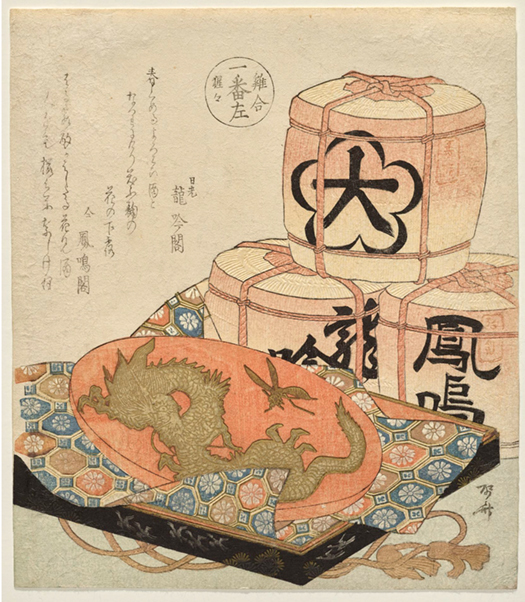
Yale University Art Gallery
This small woodblock print, known as a surimono, dates from the early nineteenth century. About 19 by 22 centimeters, it features a large sake cup with a dragon design, along with three bales of sake. It will be on view at the gallery from late summer until November 10 as part of a current exhibition celebrating the Year of the Dragon.
View full image

Yale University Art Gallery
This small woodblock print, known as a surimono, dates from the early nineteenth century. About 19 by 22 centimeters, it features a large sake cup with a dragon design, along with three bales of sake. It will be on view at the gallery from late summer until November 10 as part of a current exhibition celebrating the Year of the Dragon.
View full image
A surimono is a type of small woodblock print that was privately commissioned by poetry circles, kabuki enthusiasts, and other connoisseurs in early nineteenth-century Japan. They were produced in limited numbers, with expensive materials such as metallic pigments, and techniques such as embossing were used to create exquisite gems on paper. Surimono were full of literary allusions, wordplay, and puns, both verbal and visual, and most often contained crazy poems of 31 syllables called kyōka.
The enigmatic surimono shown on the facing page, called The Drinking Match: Mythical Ape, was created by the Japanese artist Ryūryūkyo Shinsai (ca. 1764–ca. 1820). One of 280 surimono that are promised gifts to the Yale University Art Gallery, it is in the collection of Virginia Shawan Drosten and Patrick Kenadjian ’70. It will go on view at the gallery later this summer as part of a current exhibition celebrating the Year of the Dragon.
The image shows a large sake cup with a dragon design, along with three bales of sake bearing large characters in sumi ink. The cup has just been unwrapped from a heavy octagon-patterned silk resembling a turtle’s carapace. Within each octagon is a nine-petal chrysanthemum printed in silver. On the vermilion-lacquered interior of the shallow sake cup is a coiled copper-green and gold dragon looking curiously at a large bee. The dragon is shown with its usual attributes: claws like a hawk, scales like a carp, and body like a snake. The dragon is considered a sacred animal in the East because it is believed to usher in winds, clouds, and abundant rain. It is fitting that a dragon image would grace a sake brand that requires excellent water.
Sake barrels are generally made of cedar, because the wood imbues the liquor with its fragrance. No metal or nails are used in their construction. We see that each barrel is wrapped in straw and securely held with cord. The thin, rhythmic embossing, a time-consuming technique, highlights the texture of the straw. The top barrel bears the Chinese character for “large,” which is placed within a five-petal plum-blossom design. The etymology of the character is the shape of a man standing tall, spreading his arms and legs wide open. We do not know the significance of this design combination. The calligraphy on the exterior of the other two barrels, written in black sumi ink, reads “Hōmei” or “Phoenix Cry” on the lower right, and “Ryūgin” or “Dragon Chant” on the left. The two names most likely indicate sake brands of the time, but they also introduce the two poets—members of the Peony Poetry Club of the city of Nikkō—whose names are written on the upper left of the surimono. Further research reveals that there was indeed an old sake brand called “Hōryūhai,” which means “Bee and Dragon Cup.” The sake was considered so delicious that it could make a dragon dance, but its taste was sharp like a bee sting. This explains the design of the dragon and bee on the vermilion cup.
The text in the large circle at the top center of the image includes the title of the surimono, which is pronounced tori awase in Japanese and means “matching game.” However, it is written with unusual characters, and thus the meaning has changed to “Chicken Match”! Such tongue-in-cheek humor tells us that this surimono was a contender in competitions that would determine the most enigmatic, the most sophisticated, or simply the most downright hilarious surimono. Moreover, inside the large circle, the vertical writing on the left can be pronounced in two ways: one is Shōshō, meaning this poet is “quite a drinker”; the other is Shōjō—and the characters can be interpreted to mean either “orangutan” (indicating a heavyweight drinker) or “a mythical primate with orange mask, clothes, and hair.” The competitive spirit among the participants must have been quite robust.
The two poems at upper left are also cryptic, but they are springtime poems. The first says, “The rice kōji [fermentation that makes sake] will smile under the flower dew,” and the second poem reads, “Under the spring mist, those gathered for the cherry-blossom viewing would begin to look like pink blossoms themselves, after exchanging cups.”
Looking at this surimono as a whole, we see something new. A tray at the lowest section holding the vermilion-color sake cup with the dragon. The tray’s sides bear seven birds, perhaps cranes flying over evergreen pine trees. Both cranes and pines are celebrated symbols of good luck and longevity.
 loading
loading